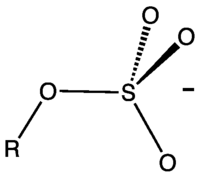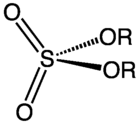- Organosulfate
-
Organosulfates are a class of organic compounds sharing a common functional group commonly with the structure R-O-SO3-. The SO4 core is a sulfate group and the R group is any organic residue. All organosulfates are formally esters derived from alcohols and sulfuric acid, although many are not prepared in this way. Many sulfate esters are used in detergents, and some are useful reagents. Alkyl sulfates consist of a hydrophobic hydrocarbon chain, a polar sulfate or sulfonate group (containing an anion) and either a cation or amine to neutralize the sulfate group. Examples include: sodium lauryl sulfate (also known as sulfuric acid mono dodecyl ester sodium salt) and related potassium and ammonium salts.
Contents
Applications
Alkyl sulfates are commonly used as an anionic surfactant in liquid soaps, detergents to clean wool, surface cleaners, as active ingredients in laundry detergents, shampoos and conditioners. They can also be found in other household products such as toothpastes, antacids, cosmetics and foods. Generally they are found in consumer products at concentrations ranging from 3-20%. In 2003 approximately 118,000 t/a of alkyl sulfates were used in the U.S.[1]
Synthetic organosulfates
A common example is sodium lauryl sulfate, with the formula CH3(CH2)11OSO3Na. Also common in consumer products are the sulfate esters of ethoxylated fatty alcohols such as those derived from lauryl alcohol. An example is sodium laureth sulfate, an ingredient in some cosmetics.[2]
Preparation
Alkylsulfate can be produced from alcohols, which in turn are obtained by hydrogenation of animal or vegetable oils and fats or using the Ziegler process or through oxo synthesis. If produced from oleochemical feedstock or the Ziegler process, the hydrocarbon chain of the alcohol will be linear. If derived using the oxo process, a low level of branching will appear usually with a methyl or ethyl group at the C-2 position, containing even and odd amounts of alkyl chains.[3] These alcohols react with chlorosulfuric acid:
- ClSO3H + ROH → ROSO3H + HCl
Some organosulfates can be prepared by the Elbs persulfate oxidation of phenols and the Boyland-Sims oxidation of anilines.
Dialkylsulfates
A less common family of organosulfates have the formula R-O-SO2-O-R'. They are prepared from sulfuric acid and the alcohol. The main examples are diethyl sulfate and dimethyl sulfate, colourless liquids that are used as reagents in organic synthesis. These compounds are potentially dangerous alkylating agents.
Natural sulfate esters
The reduction of sulfate in nature involves the formation of one or sometimes two sulfate esters, adenosine 5'-phosphosulfate (APS) and 3'-phosphoadenosine-5'-phosphosulfate (PAPS). Sulfate is an inert anion, so nature activates it by the formation of these ester derivatives, which are susceptible to reduction to sulfite. Many organisms utilize these reactions for metabolic purposes or for the biosynthesis of sulfur compounds required for life.[4]
Safety
Because they are widely used in commercial products, the safety aspects of organosulfates are heavily investigated.[5]
Human Health
Alkyl sulfates if ingested are well absorbed and are metabolized into a C3, C4 or C5 sulfate and an additional metabolite. The highest irritant of the alkyl sulfates is sodium laurylsulfate with the threshold before irritation at a concentration of 20%. Surfactants in consumer products are typically mixed reducing likelihood of irritation. According to OECD TG 406, alkyl sulfates in animal studies were not found to be skin sensitizers.[6][7]
Laboratory studies have not found alkyl sulfates to be genotoxic, mutagenic or carcinogenic. No long term reproductive effects have been found.[8]
Environment
The primary disposal of alkyl sulfate from used commercial products is wastewater. The concentration of alkylsulfates in effluent from waste water treatment plants (WWTP) has been measured at 10ug/l and lower. Alkyl sulfates biodegrade easily, even starting likely before reaching the WWTP. Once at the plant, they are rapidly removed by biodegradation. Invertebrates were found to be the most sensitive trophic group to alkyl sulfates. Sodium laurylsulfate tested on Uronema parduczi, a protozoan, was found to have the lowest effect value with the 20 h-EC5 being 0.75 mg/l. Chronic exposure tests with C12 to C18 with the invertebrate Ceriodaphnia dubia found the highest toxicity is with C14 (NOEC was 0.045mg/l).
In terms of thermal stability, alkyl sulfates degrade well before reaching their boiling point due to low vapor pressure (for C8-18 from 10-11 to 10-15 hPa). Soil sorption is proportional to carbon chain length, with a length of 14 and more having the highest sorption rate. Soil concentrations have been found to vary from 0.0035 to 0.21 mg/kg dw.
References
- ^ CEH (October 2004). "Surfactants, household detergents and their raw materials". CEH Marketing Research Report.
- ^ Eduard Smulders, Wolfgang von Rybinski, Eric Sung, Wilfried Rähse, Josef Steber, Frederike Wiebel, Anette Nordskog “Laundry Detergents” in Ullmann's Encyclopedia of Industrial Chemistry 2007, Wiley-VCH, Weinheim. doi:10.1002/14356007.a08_315.pub2.
- ^ Klaus Noweck, Wolfgang Grafahrend, "Fatty Alcohols" in Ullmann’s Encyclopedia of Industrial Chemistry 2006, Wiley-VCH, Weinheim. {{doi:10.1002/14356007.a10 277.pub2}}
- ^ M. T. Madigan, J. M. Martinko, J. Parker “Brock Biology of Microorganisms” Prentice Hall, 1997. ISBN 0-13-520875-0.
- ^ SDA/Alkylsulfate consortium (2007). "SIDS Initial Assessment Profile. SIAM 25: Alkyl Sulfates, Alkane Sulfonates, and α-Olefin sulfonates". OECD SIDS. Helsinki. http://www.aciscience.org/docs/Alkyl_Sulfates_SIAR.pdf.
- ^ SDA/Alkylsulfate Consortium (2007). "SIDS Initial Assessment Report for SIAM 25: Category of Alkyl sulfates, Alkane sulfonates, and α-Olefin sulfonates". OECD SIDS. Helsinki. http://www.aciscience.org/docs/Alkyl_Sulfates_SIAR.pdf.
- ^ DE/ICCA (2009). "SIDS Initial Assessment Profile SIAM 25: Alkyl Sulfates, Alkane Sulfonates, and α-Olefin sulfonates". OECD. http://webnet.oecd.org/Hpv/ui/handler.axd?id=623b8816-4af0-483d-b994-2e9f5e985402.
- ^ Wibbertmann, A; Mangelsdorf, I.; Gamon, K.; Sedlak, R. (2011). "Toxicological properties and risk assessment of the anionic surfactants category: Alkyl sulfates, primary alkane sulfonates, and α-Olefin sulfonate". Ecotoxicology and Environmental Safety 74 (5). doi:10.1016/j.ecoenv.2011.02.007.
Categories:- Organic compounds
- Organosulfates
Wikimedia Foundation. 2010.


